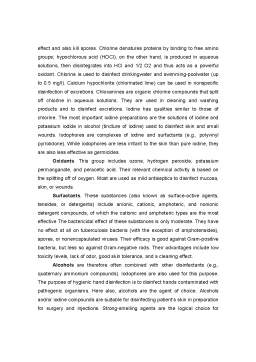Extras din curs
Sterilization is defined as the killing or removal of all microorganisms and
viruses from an object or product. Sterilization is the killing of all microorganisms and viruses or their complete elimination from a material with the highest possible level of certainty. An object that has been subjected to a sterilization process, then packaged so as to be contamination-proof, is considered sterile. The standard sterilization methods used in medical applications are capable of causing irreversible damage to medically relevant microorganisms such as bacteria, protozoans, fungi, and helminths including worm eggs. Much more extreme processes are required to inactivate prions, such as autoclaving at 121 °C for 4.5 hours. Hyperthermophilic archaea forms have also been discovered in recent years that proliferate at temperatures of 100 °C and higher and can tolerate autoclaving at 121 °C for one hour.
Disinfection means rendering an object, the hands or skin free of pathogens. Disinfection is a specifically targeted antimicrobial treatment with the objective of preventing transmission of certain microorganisms. The purpose of
the disinfection procedure is to render an object incapable of spreading infection.
The term asepsis covers all measures aiming to prevent contamination of objects or wounds.
Disinfection and sterilization makes use of both physical and chemical agents.
The sterilization agents of choice are:
- hot air (180 °C, 30 minutes) or
- saturated water vapor (121 °C,15 minutes,1 atm).
Gamma rays or high-energy electrons are used in radiosterilization.
Disinfection is usually done with chemical agents, the most important of
which are:
- aldehydes (formaldehyde),
- alcohols,
- phenols,
- halogens (I, Cl),and
- surfactants (detergents).
Decontamination is the removal or count reduction of microorganisms
contaminating an object.
The objective of aseptic measures and techniques is to prevent microbial
contamination of materials or wounds. In antiseptic measures, chemical agents are used to fight pathogens in or on living tissue, for example in a wound.
Mechanisms of Action
When microorganisms are killed by heat, their proteins (enzymes) are irreversibly denatured.
Ionizing radiation results in the formation of reactive groups that contribute to chemical reactions affecting DNA and proteins. Exposure to UV light results in structural changes in DNA (thymine dimers) that prevent it from replicating. This damage can be repaired to a certain extent by light (photoreactivation).
Most chemical agents (alcohols, phenols, aldehydes, heavy metals, oxidants) denature proteins irreversibly. Surfactant compounds (amphoteric and cationic) attack the cytoplasmic membrane. Acridine derivatives bind to DNA to prevent its replication and function (transcription).
The temperature coefficient describes the influence of temperature on the
effectiveness of chemical agents. The higher the temperature, the stronger the effect, i.e., the exposure time required to achieve the same effect is reduced. The coefficient of temperature must be determined experimentally for each combination of antimicrobial agent and pathogen species.
Preview document
Conținut arhivă zip
- Principles of Sterilization and Disinfection.doc















